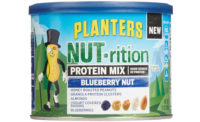Snack mixes today show much promise for widespread appeal. “There is opportunity for growth in the snack mixes industry, as we are beginning to see consumers snack almost as much as they eat full meals,” says Trip Kadey, director of culinary, The French’s Food Co. LLC, Chester, NJ.
Recent statistics from IRI, Chicago, supports the company’s findings. Sales of trail mixes rose about 5 percent in the year ending March 20, 2016, clocking in at around $1 billion in total sales. Top vendors included Kars Nuts (up 8 percent), Snak Club (up 7 percent) and Kraft Foods Group (down 2.5 percent). Private label mixes posted significant growth at over 7 percent and more than $500 million in sales, representing the biggest share of the market by far.
Jeannie Swedberg, director of business development, Tree Top, Selah, WA, attributes the growing popularity of snack mixes to demographics. “While millennials are now the largest demographic group in the U.S., boomers reportedly still spend more on snacks,” she says. “Both of these groups snack—although their motivations may be different.”
According to Swedberg, millennials are looking for snack mixes that boost their energy, fulfill their cravings and relieve stress. Boomers, on the other hand, reach for a snack mix that offers health or functional benefits, such as immune enhancement, satiety or digestive health.
That’s why snack mixes hit all the right notes. “With a snack mix,” says Swedberg , “there’s variety and the ability to offer different flavors and ingredients with benefits.”
The flavor game
Reflecting the broader food industry trends toward healthy and clean-label, the snack mix market is meeting consumer demand for pure ingredients with health-boosting benefits. AnnMarie Kraszewski, research and development lab manager, Wixon Inc., St. Francis, WI, is noticing a demand for satiety that is reflected in brands offering more fiber-rich ingredients like chickpeas and ancient grains, such as popped amaranth.
Similarly, fiber-rich almonds are in demand, according to Jeff Smith, director of marketing, Blue Diamond Almonds, Global Ingredients Division, Sacramento, CA, as they boast 4 grams of fiber per ounce, providing “both energy and lasting satisfaction.”
But it’s primarily with bold new flavors that snack mix brands are differentiating themselves on the shelf. According to Smith, Blue Diamond works with customers to create new flavor profiles for almonds, like “sweet flavors such as orange, honey and coconut, and savory flavors such as bacon.”
That’s likely because spices can lend a “gourmet exoticism and adventure” to mixes, says Steve Bryant, U.S. Marketing Director, Turkish Hazelnut Promotion Group, Seattle. He notes that ingredients with a sense of place can entice shoppers. “In both fruits and nuts, specific origins are being cited to suggest greater selectivity and refinement, helping to incite trial,” he says. “Sure, you’ve had hazelnuts, but have you tried Turkish hazelnuts? It’s not just any kind of fig; it’s an Anatolian fig.”
“Consumers today, especially millennials, love new flavor twists on traditional snacks,” says Megan O’Keefe, media relations, SaltWorks Inc., Woodinville, WA, “from black truffle salt in snack mixes to a smoked salt on a chocolate-covered nut.” The company’s Fusion Sriracha Salt remains popular, while other savory options, such as Fusion Black Truffle or Robusto Hearty Smoked Sea Salt, are also in demand to elevate flavor profiles. And because they’re natural sea salts, they haven’t been chemically processed and offer a stronger impact of salty flavor, she says, adding that “in some instances, manufacturers using our salts have been able to reduce the amount of salt used overall,” which further appeals to health-conscious consumers.
According to Swedberg, Asian and Latin American flavors have broad appeal among millennials, who like to try new foods and flavors with sweet-and-savory or sweet heat notes. Brands are also putting a twist on old favorites, she says, like sweetening up traditionally salty mixes or adding savory flavors to traditionally sweet offerings. “Adding fruit is a good way to add sweet to spicy flavors,” she advises, noting that dried apples and infused fruits make sense in a spicy mix.
Special challenges
With a growing market comes growing challenges for snack mix manufacturers. “It’s a highly competitive category with more players entering every year, including the very largest manufacturers and global food companies that had not been in the category previously,” says Smith. “Smaller, niche companies may have the biggest challenge in ‘keeping up’ and maintaining their sales and distribution channels.”
That’s because, as Kraszewski explains, sourcing the unique raw materials demanded by consumers can be a real challenge. “They may not be available industrially,” she says. “Sometimes, if we are able to find it, the cost may not be appropriate for that particular project.”
That’s why Bryant recommends working with rising market prices, rather than against them. For example, brands shouldn’t balk at including pricey chocolate in a snack mix, since very little of the product may be needed to make a big taste impact. Putting smaller amounts of expensive or exclusive ingredients in a snack mix, then, can be a smart way to give consumers the crave-worthy flavors they desire, while keeping costs low. “The higher prices of chocolate may factor into snacking formulations, but this might actually favor snack mixes containing chocolate,” he explains. “This allows consumers to get a quality chocolate fix without buying a dark chocolate bar at prices now approaching $5.”
Additionally, says Bryant, because demands from Asia and Europe are currently soft on fruit and nuts, American snack brands are in a great position to negotiate good pricing and a reliable supply of these ingredients.
But changes in formulation can also often mean changes on the production line, which could work either for or against a particular brand, depending on size. To that end, Nathan Lee, vice president of sales, PPM Technologies, LLC, Newberg, OR, says: “Consumer demands are ever-changing. Being a micro manufacturer enables the producer to be more flexible to new consumer demands and adjust the production run accordingly.”
Forward thinking
Looking ahead, two unique opportunities present themselves to snack mix manufacturers, and they come in the form of two very different, very influential demographics.
Thanks to baby boomers, opportunities for growth include products with “flavor innovation, portion control and functional benefits like immune enhancement, sports recovery, endurance, satiety, digestive health, protein and fiber,” says Swedberg. “As consumers become more nutritionally savvy, they’ll want snacks that fit their nutritional needs.”
Millennials, on the other hand, are rapidly gaining buying power and also reaching their peak childbearing years, which means growing families and larger households, says Bryant. This group has “a snacking ethic such as the market has never seen in prior generations,” he says, thanks to their inclination to eat far more of their meals as snacks. “The millennial mindset will view most occasions as mini meals,” he says. “In their view, snacks are digitized and modular food units. Mix in the occasional, old-fashioned meal, and it adds up to a diet. Snack makers should be licking their chops as the snacking generation enters its prime.”







